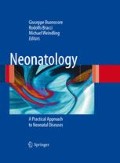Abstract
The electroencephalogram (EEG) reflects brain function and is an important diagnostic tool for infants requiring neonatal intensive care, not least since neurological symptoms may be very vague, or entirely absent. The EEG can be used for early detection of general or focal cerebral abnormalities, and also to give important predictive information on later neurodevelopmental outcome.
Access this chapter
Tax calculation will be finalised at checkout
Purchases are for personal use only
References
André M, Lamblin MD, d’Allest AM et al (2010) Electroencephalography in premature and full-term infants. Developmental features and glossary. Neurophysiol Clin 40: 59–124
Lamblin MD, André M, Challamel MJ et al (1999) Electroencephalography of the premature and term newborn. Maturational aspects and glossary. Neurophysiol Clin 29: 123–219
Mizrahi EM, Hrachovy RA, Kellaway P (2004) Atlas of neonatal encephalography, 3rd edn. Lippincott Williams & Wilkins, Philadelphia
Vanhatalo S, Kaila K (2006) Development of neonatal EEG activity: from phenomenology to physiology. Semin Fetal Neonatal Med 11: 471–478
Victor S, Appleton RE, Beirne M et al (2005) Spectral analysis of electroencephalography in premature newborn infants: normal ranges. Pediatr Res 57: 336–341
Watanabe K, Hayakawa F, Okumura A (1999) Neonatal EEG: a powerful tool in the assessment of brain damage in preterm infants. Brain Dev 21: 361–372
Menache CC, Bourgeois BF, Volpe JJ (2002) Prognostic value of neonatal discontinuous EEG. Pediatr Neurol 27: 93–101
Okumura A, Hayakawa F, Kato T et al (2002) Developmental outcome and types of chronic-stage EEG abnormalities in preterm infants. Dev Med Child Neurol 44: 729–734
Marret S, Parain D, Jeannot E et al (1992) Positive rolandic sharp waves in the EEG of the premature newborn: a five year prospective study. Arch Dis Child 67: 948–951
Nguyen The Tich S, Vecchierini MF, Debillon T, Péréon Y (2003) Effects of sufentanil on electroencephalogram in very and extremely preterm neonates. Pediatrics 111: 123–128
Shany E, Benzaquen O, Friger M et al (2008) Influence of antiepileptic drugs on amplitude-integrated electroencephalography. Pediatr Neurol 39: 387–391
Shellhaas RA, Clancy RR (2007) Characterization of neonatal seizures by conventional EEG and single-channel EEG. Clin Neurophysiol 118: 2156–2161
Patrizi S, Holmes GL, Orzalesi M, Allemand F (2003) Neonatal seizures: characteristics of EEG ictal activity in preterm and fullterm infants. Brain Dev 25: 427–437
Hellström-Westas L, de Vries LS, Rosén I (2008) An atlas of amplitude- integrated EEG’s in the newborn, 2nd edn. Informa Healthcare, London
Spitzmiller RE, Phillips T, Meinzen-Derr J, Hoath SB (2007) Amplitude- integrated EEG is useful in predicting neurodevelopmental outcome in full-term infants with hypoxic-ischemic encephalopathy: a meta-analysis. J Child Neurol 22: 1069–1078
Mariani E, Scelsa B, Pogliani L et al (2008) Prognostic value of electroencephalograms in asphyxiated newborns treated with hypothermia. Pediatr Neurol 39: 317–324
Thoresen M, Hellström-Westas L, Liu X, de Vries LS (2010) Effect of hypothermia on amplitude-integrated electroencephalogram in infants with asphyxia. Pediatrics 126: e131–e139
Yap V, Engel M, Takenouchi T, Perlman JM (2009) Seizures are common in term infants undergoing head cooling. Pediatr Neurol 41: 327–331
Hellström-Westas L, Klette H, Thorngren-Jerneck K, Rosén I (2001) Early prediction of outcome with aEEG in preterm infants with large intraventricular haemorrhages. Neuropediatrics 32: 319–324
Author information
Authors and Affiliations
Editor information
Editors and Affiliations
Rights and permissions
Copyright information
© 2012 Springer-Verlag Italia
About this chapter
Cite this chapter
Hellström-Westas, L.K. (2012). Neonatal Electroencephalography. In: Buonocore, G., Bracci, R., Weindling, M. (eds) Neonatology. Springer, Milano. https://doi.org/10.1007/978-88-470-1405-3_131
Download citation
DOI: https://doi.org/10.1007/978-88-470-1405-3_131
Publisher Name: Springer, Milano
Print ISBN: 978-88-470-1404-6
Online ISBN: 978-88-470-1405-3
eBook Packages: MedicineMedicine (R0)

